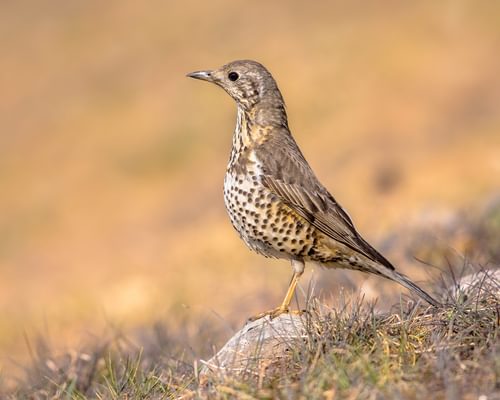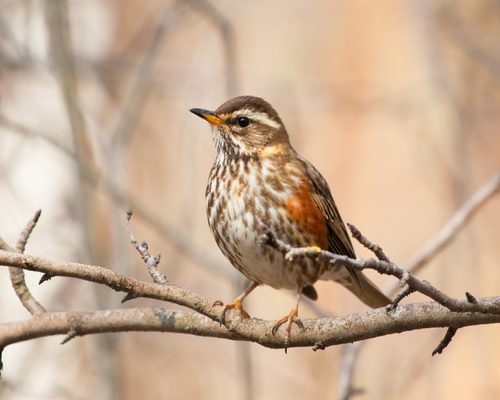Song Thrush
Turdus philomelos
Visual Identification
Appearance
The Song Thrush is a medium-sized bird with a warm brown upper body and pale buff underparts marked with distinctive dark brown triangular spots. Its head features large, dark eyes and a slightly curved bill, which is dark above but yellowish below and at the gape.
Both sexes look similar, with juveniles having a more speckled appearance. The bird maintains consistent plumage throughout the year, with no significant seasonal changes. Their legs are pinkish, and their eyes are large and black.
Size
Length
20cm to 23cm
Wingspan
33cm to 36cm
Weight
65g to 100g
Colours
Males and females have similar plumage
Primary Colour
Brown
Secondary Colour
Buff White
Beak Colour
Brown
Leg Colour
Pink
Habitat and Distribution
Habitats
Woodland
Garden
Wetland
Coastal
Urban
Farmland
Grassland
Desert
Tundra
Rainforest
Mountain
Savanna
Distribution
Song Thrushes inhabit woodlands, gardens, parks, and hedgerows across Europe, extending into parts of western Asia. They prefer areas with trees or shrubs for nesting and open ground for foraging.
In the UK, they are widespread residents and regular garden visitors, with some birds migrating south in winter. Continental European populations tend to be more migratory, moving to southern Europe and North Africa during colder months.
They were also introduced to New Zealand and South Eastern Australia in the mid-1800s and are still present today.
Elevation Range
Up to 2,800 meters
Climate zones
Temperate, Subtropical
Distribution Map
This map gives you a rough idea of where you might spot a Song Thrush. The coloured areas show countries where these birds have been seen.
A few things to keep in mind:
- Birds might not be everywhere in the coloured areas, for example, they may be present around the coast of that country
- Where birds live can change with seasons and available food
- This map is quite simple - it doesn't show exact locations
We're working on making our maps even better! Soon, we hope to show you:
- More detailed maps for bigger countries, including state and region
- How birds move around during different seasons
Distribution by Region
Behaviour and Ecology
Bird Attributes
This feature is in beta. We'd love your feedback to improve it!
Share your thoughtsBird Attributes Explained
Our bird attributes system rates various aspects of a bird's capabilities on a scale of 0-100, based on data from field observations, scientific studies, and expert knowledge.
Attribute Categories:
- Agility: Manoeuvrability, speed, and grace in flight or movement.
- Strength: Physical power, often correlating with size and hunting abilities.
- Adaptability: Ability to thrive in various environments or changing conditions.
- Aggressiveness: Territorial behaviour and assertiveness, particularly during breeding seasons.
- Endurance: Stamina, often seen in migration patterns or foraging behaviours.
Understanding the Ratings:
- 0-20: Very Low
- 21-40: Low
- 41-60: Average
- 61-80: High
- 81-100: Very High
Remember, these attributes are relative to other bird species and don't necessarily indicate superiority.
Hover over the icon next to each attribute for more information.
Tap the icon next to each attribute for more information.
Agility
Reflects the bird's manoeuvrability, speed, and grace in flight or movement.
The Song Thrush demonstrates considerable agility in its hopping behaviour across lawns and its ability to manoeuvre through woodland and garden environments. Its skill in using stones as 'anvils' to crack snail shells also indicates good dexterity.
Strength
Indicates the bird's physical power, often correlating with size and hunting abilities.
As a medium-sized bird weighing between 65-100g, the Song Thrush has moderate strength for its size. It's capable of breaking snail shells and digging for earthworms, but isn't particularly powerful compared to larger birds.
Adaptability
Represents the bird's ability to thrive in various environments or changing conditions.
Song Thrushes show high adaptability, thriving in various habitats from woodlands to urban gardens. Their ability to remember foraging locations and use tools (stones) for feeding demonstrates cognitive adaptability. They also adjust well to seasonal changes, with some populations migrating.
Aggressiveness
Measures the bird's territorial behaviour and assertiveness, particularly during breeding seasons.
Generally, Song Thrushes are not particularly aggressive birds. They're often solitary or found in pairs, becoming more social during migration. While they defend territories during breeding season, they don't exhibit notably aggressive behaviour compared to many other bird species.
Endurance
Reflects the bird's stamina, often seen in migration patterns or foraging behaviours.
Song Thrushes display good endurance, particularly evident in their migratory habits. Some populations undertake long-distance flights to southern Europe and North Africa. Their ability to maintain territories, forage extensively, and produce multiple broods per season also indicates solid endurance.
Diet
Song Thrushes primarily feed on invertebrates, including earthworms, insects, and snails. They also consume a variety of fruits and berries, especially in autumn and winter, when insects are harder to find.
Their unique method of breaking snail shells against stones is a key feeding behaviour.
Behaviour
Song Thrushes are known for their habit of using a favourite stone as an 'anvil' to crack open snail shells. They are often seen hopping across lawns, pausing to listen for earthworms.
These birds are generally solitary or found in pairs, becoming more gregarious during migration periods.
Vocalisation
The Song Thrush is renowned for its beautiful, loud, and varied song. It consists of repeated phrases, often sung three times in succession, with a rich, flute-like quality.
The song includes both melodious notes and harsh chattering sounds, sometimes mimicking other birds or environmental noises. Their alarm call is a sharp, repetitive 'tsip' or 'chook'.
Nesting & Breeding
Song Thrushes typically form monogamous pairs during the breeding season, which runs from March to August in most of their range. Males establish territories and attract females with their melodious songs.
The nest, built primarily by the female, is a sturdy cup-shaped structure made of grass, twigs, and moss, often lined with mud. It's usually placed in dense vegetation or a tree fork. The female lays 3-5 pale blue eggs with black spots.
Incubation lasts about 13-15 days, primarily by the female. Both parents feed the chicks, which fledge after 13-14 days. Pairs often produce 2-3 broods per season.
Conservation and Status
Global Conservation Status
While listed as Least Concern globally, Song Thrush populations have declined in parts of Europe, including the UK. Factors include agricultural intensification, reduction in woodland understory, and use of pesticides affecting their prey.
Conservation efforts focus on maintaining diverse habitats and promoting wildlife-friendly gardening practices.
Birdwatching Tips
- Listen for their distinctive repetitive song, often heard from high perches
- Look for them foraging on lawns, especially after rain
- Check for broken snail shells near stones, a sign of Song Thrush feeding activity
- In the UK, observe gardens and woodland edges early in the morning or at dusk
- When standing, they have a long-legged, upright stance
- The song thrush is more solitary and shy than other thrushes. However, they can grow to be quite tame.
Additional Information
Quick Facts
Predators
Main predators of Song Thrushes include domestic and feral cats, Sparrowhawks, and other birds of prey. Ground-nesting thrushes are also vulnerable to foxes and rodents.
Did You Know?
- Song Thrushes can remember the locations of their favourite anvil stones for breaking snail shells.
- They have excellent spatial memory, allowing them to recall where they've successfully foraged in the past.
- In British folklore, the Song Thrush was believed to repeat its phrases three times to teach young birds how to sing.
- The Song Thrush’s song can sometimes be heard up to half a mile away.
FAQs
How many Song Thrushes are there in the UK?
There are an estimated 1.3 million Song Thrush territories in the United Kingdom.
How to attract Song Thrushes
You can attract Song Thrushes to your garden by creating a suitable habitat for foraging and nesting. A combination of lawn, shrubs and trees, with a layer of leaf litter and mulch, will provide excellent foraging grounds for these welcome birds.
Similar Birds
References
- 1 2
website: BirdLife International. 2018. Turdus philomelos. The IUCN Red List of Threatened Species 2018: e.T22708822A132076619.
View source - 3
report, 2015: EBCC
- 4
website, 2010: Fransson et al., EURING list of longevity records for European birds
View source
Share Your Feedback
We value your opinion! Let us know what you think about this bird page.


